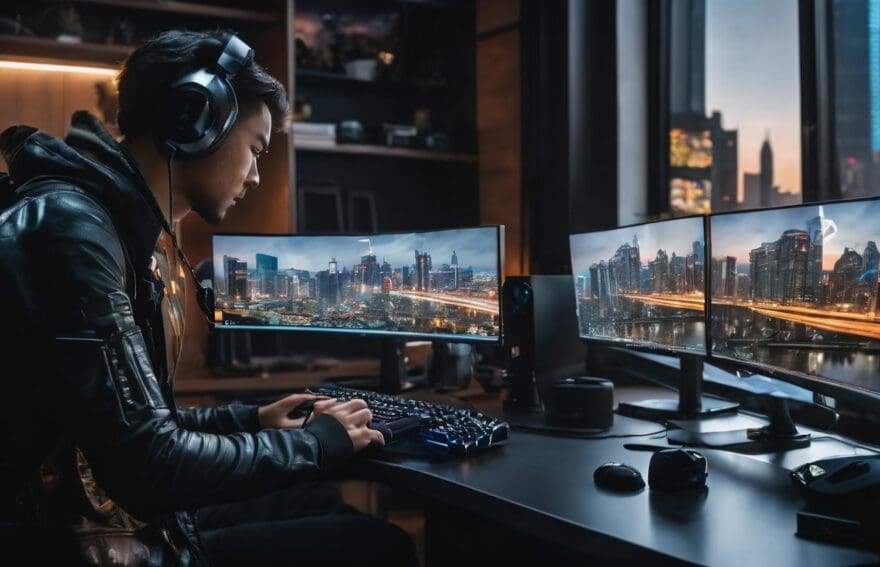Optimizing Your PC for Esports: A Software Tuning Guide

Updated On: November 13, 2025 by Aaron Connolly
We’ve all experienced that maddening stutter at the most inconvenient of times, disrupting an otherwise thrilling game and leaving us a tad irked. Sharing in this common frustration is what drove us to comb through various ways to fine-tune PCs for peak gaming performance.
Our guide is brimming with straightforward adjustments guaranteed to boost your frame rate and enhance your gaming sessions to rival those of the pros. So why not join us on this journey and uncover the secrets to seizing that competitive advantage?.
What is Esports and Why is PC Optimisation Important?
Esports demands precision, speed, and the utmost responsiveness. Every millisecond counts in competitive gaming, where reaction times can be the difference between winning and losing.
Optimising your PC ensures that you’re squeezing every bit of performance out of your system. We look for ways to increase FPS and boost gaming performance because we want our machines to work as hard as we do in-game.
With regular updates to operating systems and graphic drivers, PCs stay at the peak of their game. We make these tweaks not just for a smoother experience but also to reduce latency during gameplay which is crucial when facing skilled opponents online.
High performance mode isn’t just an option; it’s a necessity for us who take esports seriously—ensuring that background processes don’t siphon off precious resources from where they’re needed most: keeping us on top of the leaderboard.
Preparing Your PC for Optimal Gaming Performance
Ensure that your PC is ready for optimal gaming performance by updating your drivers, disabling unnecessary background apps, and enabling high-performance mode. These steps will help to minimise distractions and maximise the resources available for a smooth gaming experience.
Update your drivers
Updating your drivers is crucial for optimising your PC’s performance for esports. By ensuring that your graphic and audio drivers are up to date, you can experience smoother gameplay and improved frame rates.
Regularly checking for driver updates from your hardware manufacturer’s website or using automated tools can help ensure that you have the latest optimisations and bug fixes installed.
Keeping your drivers updated not only enhances system stability but also ensures compatibility with the latest games. It’s an easy yet effective way to fine-tune your PC setup for gaming without requiring any additional investment in hardware upgrades.
Disable unnecessary background apps
When gaming, it’s essential to disable unnecessary background apps to free up system resources and ensure smooth gameplay. Unnecessary apps running in the background can consume valuable CPU and memory, impacting game performance.
By disabling these apps, you can allocate more resources to your game and prevent any interruptions or slowdowns during intense gaming sessions.
Optimising your PC for esports involves taking full control of the resources available, and one effective way is by disabling unwanted background applications. This action allows your PC to focus entirely on delivering a high-quality gaming experience without any hindrances from other non-essential processes.
Enable high performance mode
We can further enhance our PC’s gaming performance by enabling high-performance mode. This setting allows our system to allocate more resources to running games and applications, boosting overall performance.
By activating high-performance mode, we ensure that our PC prioritises speed and responsiveness, delivering a smoother gaming experience with increased frames per second (FPS) and reduced input lag.
This simple tweak can make a significant difference in optimising our PC for esports without the need for hardware upgrades.
Advanced Software Tuning Techniques
Fine-tune your mouse settings, adjust in-game settings, and utilise game mode to enhance your gaming performance. Click here to learn more about maximising your PC for the ultimate esports experience.
Adjusting in-game settings
Adjusting in-game settings can have a significant impact on your gaming experience. Tweaking graphics, resolution, and other game-specific options can help boost FPS and enhance overall performance.
By lowering some graphical settings, you can prioritise frame rate over visual fidelity, resulting in smoother gameplay. It’s essential to experiment with different settings to find the right balance between performance and visuals for each game.
Optimising in-game settings goes beyond just graphics; adjusting mouse sensitivity, keybindings, and audio levels also contribute to an optimal gaming experience. Finding the perfect combination of settings tailored to your preferences can make a noticeable difference in how you perform in-game.
Fine-tuning your mouse settings
To optimise your gaming experience, fine-tune your mouse settings to improve precision and response time. Adjusting the sensitivity and DPI (dots per inch) of your mouse can enhance accuracy and make in-game movements more responsive.
Maximising the polling rate of your mouse will also result in smoother cursor movement, crucial for fast-paced esports gameplay.
By configuring these settings, you can ensure that every click and movement translates seamlessly into the game, giving you a competitive edge. This optimisation method is an essential step towards achieving peak performance when gaming competitively on your PC.
Adjusting your monitor refresh rate
To optimise your gaming performance, adjusting your monitor’s refresh rate is essential. A higher refresh rate allows for smoother gameplay and reduces motion blur, enabling you to react faster in fast-paced games.
By ensuring that your monitor’s refresh rate matches the frame rate of your game, you can experience a more fluid and responsive gaming experience. This adjustment can significantly enhance your overall esports performance by providing clearer visuals and reducing input lag.
When fine-tuning your PC for optimal esports performance, another crucial aspect to consider is disabling Nagle’s algorithm.
Disabling Nagle’s algorithm
To enhance your gaming experience, consider disabling Nagle’s algorithm on your Windows PC. This algorithm is designed to improve network efficiency by bundling small packets of data together; however, it can cause delays in transmitting real-time information during online gaming.
By turning off Nagle’s algorithm, you can reduce latency and ensure smoother gameplay. Accessing the Windows Registry Editor allows you to make this adjustment and optimise your system for esports performance.
By tweaking this setting, you can directly impact the speed and responsiveness of your online gameplay without needing additional hardware upgrades or expensive software modifications.
Using a faster DNS
After enhancing our gaming performance by disabling Nagle’s algorithm, another software tuning technique to consider is using a faster DNS. By switching to a faster Domain Name System (DNS) server, you can experience reduced latency and quicker response times when accessing online games and services.
This optimisation can lead to smoother gameplay and improved overall gaming experience. Upgrading your DNS server is an often-overlooked step in the pursuit of optimising PC performance for esports.
Maximising your gaming potential involves paying attention to every aspect of your system’s configuration, including less obvious components like the DNS server. By selecting a faster DNS service, you can further enhance your PC’s ability to connect with game servers swiftly and efficiently.
Utilising game mode
To improve gaming performance, enabling game mode on Windows 10 or 11 can enhance your PC’s capabilities for esports. By prioritising system resources for the game you’re playing, game mode allocates more CPU and GPU power to boost frame rates and reduce latency.
This setting optimises your PC specifically for gaming, ensuring a smoother experience with improved responsiveness. With just a few clicks in the settings menu, gamers can unlock better performance without needing to make complex adjustments.
Enabling game mode allows you to maximise your hardware capability while fine-tuning software settings. The feature helps ensure that your PC is running at its best when playing esports titles, allowing for an immersive and seamless gaming experience on Windows-based systems.
Hardware Upgrades for Optimal Esports Performance
When it comes to hardware upgrades for optimal esports performance, consider upgrading your GPU, CPU, and RAM to ensure smooth gameplay and faster processing. Installing an SSD, using an external power supply, and keeping your laptop from overheating are also important factors to consider for enhancing your gaming experience.
Upgrading your GPU, CPU, and RAM
Upgrading your GPU, CPU, and RAM is vital for boosting performance in esports gaming. An improved graphics processing unit (GPU) enhances visual quality and frame rates, resulting in a smoother gaming experience.
Upgrading your central processing unit (CPU) increases the speed at which your computer can process data, leading to faster game loading times and better overall performance. Additionally, enhancing random access memory (RAM) allows your PC to handle more tasks simultaneously without slowing down, improving multitasking ability during gameplay.
Increasing FPS on PC is closely tied to upgrading these hardware components. A powerful GPU handles more graphical data and contributes significantly to higher frame rates. Likewise, a robust CPU ensures that game logic and AI are processed efficiently, while ample RAM reduces loading times and provides a seamless gaming experience.
Installing an SSD
Optimising your PC for esports by installing an SSD can significantly enhance your gaming experience. Upgrading to a solid-state drive not only speeds up game loading times but also improves overall system performance.
Utilising an SSD reduces in-game lag and provides smoother gameplay, giving you a competitive edge in high-speed gaming environments. Taking this hardware optimisation step is essential for boosting FPS and ensuring seamless gameplay.
Esports enthusiasts are increasingly recognising the value of enhanced hardware, and upgrading to an SSD is a key aspect of PC optimisation. The difference in speed and responsiveness will be noticeable from the moment you install it, making it well worth the investment for any serious gamer wanting to maximise their gaming capabilities.
Using an external power supply
To ensure consistent and stable power delivery, utilising an external power supply can be beneficial for optimising your PC’s performance during intense gaming sessions. This additional power source can help prevent sudden shutdowns or performance dips caused by insufficient power from the internal supply.
By providing a reliable and steady stream of electricity to your gaming rig, you can maintain smooth gameplay without disruptions.
Upgrading to an external power supply also allows for better management of overall system heat, as it reduces strain on the internal components responsible for powering the PC. This enhancement contributes to a more efficient and cooler-running system, ultimately supporting improved gaming performance.
Keeping your laptop from overheating
To maintain peak gaming performance, it is crucial to keep your laptop from overheating. Overheating can lead to reduced system performance and even hardware damage over time. Utilise a cooling pad or laptop stand with built-in fans to improve airflow and dissipate heat effectively.
Regularly clean the vents and ensure that they are unobstructed by dust or debris, as this can prevent proper ventilation and cause heat buildup. Additionally, adjusting power settings to prioritise cooling during gaming sessions can help manage system temperature more efficiently.
By taking proactive measures to address overheating issues, you can safeguard your laptop’s performance while ensuring smooth gameplay experiences without interruptions due to thermal constraints.
The Best Gaming PCs to Consider
We will also explore some of the best gaming PCs available on the market to take your esports experience to the next level. Read on to find out more!
OMEN by HP 45L Gaming Desktop GT22-1470se
The OMEN by HP 45L Gaming Desktop GT22-1470se offers impressive features for an enhanced esports experience. Its powerful hardware, including advanced GPU and CPU options, ensures smooth gameplay and improved FPS during intense gaming sessions.
Additionally, the desktop’s spacious storage capacity and fast SSD contribute to reduced load times and quicker system responsiveness, optimising the overall gaming performance.
Equipped with Windows 11, this gaming desktop can be further optimised for esports. The operating system provides a platform for fine-tuning game settings, maximising graphics potential, and utilising Game Mode for elevated performance.
Victus by HP 15L Gaming Desktop
Boost your gaming performance with the Victus by HP 15L Gaming Desktop. With its powerful hardware and customisable settings, you can optimise your PC for esports to experience smoother gameplay and increased FPS.
The advanced GPU, CPU, and RAM allow for seamless multitasking and enhanced graphics, while the high-speed SSD ensures quick load times. Plus, take advantage of Windows 11 optimisation features to further elevate your gaming experience.
By upgrading to this gaming desktop, you’ll be able to fine-tune game settings, boost overall performance, and enjoy a competitive edge in the world of esports.
OMEN by HP Laptop 17-cm2047nr
The OMEN by HP Laptop 17-cm2047nr is a top-tier gaming laptop that offers exceptional performance for esports enthusiasts. Equipped with powerful hardware, including the latest Intel Core processor and NVIDIA GeForce graphics, this laptop ensures smooth gameplay and fast frame rates to give you a competitive edge in your favourite games.
With its high refresh rate display and advanced cooling system, the OMEN by HP Laptop 17-cm2047nr delivers an immersive gaming experience while keeping the system cool even during intense gaming sessions.
Utilising the OMEN Command Center allows you to fine-tune game settings and prioritise network traffic for lag-free online gaming. Its sleek design and customisable RGB keyboard add a touch of personalisation to your setup, making it an ideal choice for gamers looking to optimise their PC for esports.
Victus by HP Laptop 15z-fb000
Optimise your gaming experience with the Victus by HP Laptop 15z-fb000. This powerful machine offers seamless gameplay with its high-performance AMD Ryzen processors and NVIDIA GeForce graphics.
With this laptop, you can easily fine-tune in-game settings and enhance FPS for a smoother gaming experience. Its fast SSD storage ensures quick load times, while the faster DNS helps reduce lag during online play.
When updating your drivers, don’t forget to enable game mode to prioritise system resources for gaming. The laptop’s sleek design doesn’t compromise on cooling efficiency, allowing you to enjoy extended hours of intense esports action without overheating concerns.
Conclusion
In conclusion, optimising your PC for esports can significantly enhance gaming performance. Upgrading hardware and tweaking software settings are crucial steps to boost FPS and overall gaming experience.
By fine-tuning in-game settings and keeping drivers up to date, you can maximise your PC’s potential for seamless gameplay. With the right adjustments, you can elevate your gaming experience to a whole new level.
FAQs
1. How can I optimise my PC for esports gaming?
To enhance your PC’s performance for esports, you can update drivers, adjust Game Mode settings in Windows, and fine-tune other system optimisations specifically for gaming.
2. Will updating my PC software improve my gaming experience?
Yes, regularly upgrading your PC with the latest drivers and software tweaks ensures smoother gameplay and maximises gaming performance.
3. What does tweaking PC settings do for my esports performance?
Tweaking your PC settings helps boost FPS (frames per second), which is crucial in improving your overall gaming and esports performance on Windows computers.
4. Can optimising Windows really make a difference in playing games better?
Absolutely! Optimising your Windows setup by adjusting game settings and streamlining processes can significantly increase gaming performance on your PC.
5. Is there a specific guide to set up my computer for the best esports experience?
Yes, there are various Esports PC setup guides and tips available that focus on software tuning to help ensure your computer is perfectly optimised for top-level competitive gaming.


